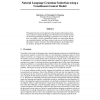Free Online Productivity Tools
i2Speak
i2Symbol
i2OCR
iTex2Img
iWeb2Print
iWeb2Shot
i2Type
iPdf2Split
iPdf2Merge
i2Bopomofo
i2Arabic
i2Style
i2Image
i2PDF
iLatex2Rtf
Sci2ools
135
click to vote
NIPS
2001
2001
Natural Language Grammar Induction Using a Constituent-Context Model
This paper presents a novel approach to the unsupervised learning of syntactic analyses of natural language text. Most previous work has focused on maximizing likelihood according to generative PCFG models. In contrast, we employ a simpler probabilistic model over trees based directly on constituent identity and linear context, and use an EM-like iterative procedure to induce structure. This method produces much higher quality analyses, giving the best published results on the ATIS dataset. 1 Overview To enable a wide range of subsequent tasks, human language sentences are standardly given tree-structure analyses, wherein the nodes in a tree dominate contiguous spans of words called constituents, as in figure 1(a). Constituents are the linguistically coherent units in the sentence, and are usually labeled with a constituent category, such as noun phrase (NP) or verb phrase (VP). An aim of grammar induction systems is to figure out, given just the sentences in a corpus S, what tree str...
Related Content
| Added | 31 Oct 2010 |
| Updated | 31 Oct 2010 |
| Type | Conference |
| Year | 2001 |
| Where | NIPS |
| Authors | Dan Klein, Christopher D. Manning |
Comments (0)

